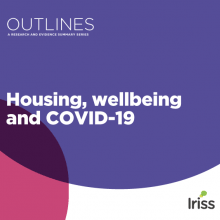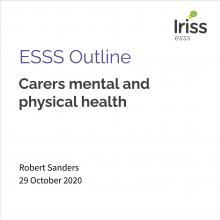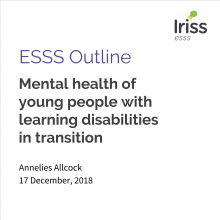Introduction
A Better Life was a major five year programme of work developed by the Joseph Rowntree Foundation which explored how to achieve a good quality of life for older people with high support needs. This briefing has been produced by Iriss to ensure that the messages and challenges of A Better Life are understood in the context of the current policy drivers in Scotland and are translated into practice across the country.
From the varied projects comprising the JRF programme, seven key challenges have been identified. These are listed opposite and offer the essence of what needs to be achieved as policies are translated into practice. Legislation and policy guidance can only ever provide a skeleton framework for what is desired. It is the ways in which each and every citizen, whether a professional, a family member or friend, a community resident or a person with high support needs, interacts with those around them that creates the culture in which we grow older. The following pages offer signposts and examples of ways in which we can seek to respond to these critical challenges. For those paid to provide support this demonstrates how simple things that can readily be achieved are often key to a better quality of life; for everyone else it suggests the contributions we can both make and demand.
JRF's definition of 'older people with high support needs' - Older people of any age who need a lot of support due to physical frailty, chronic conditions and/or multiple impairments (including dementia). Most will be over 85 years old, though some will be younger. Many will be affected by other factors including poverty, disadvantage, nationality, ethnicity, lifestyle etc. Some of the very oldest people may never come into this category.

The Seven Challenges
- We all need positive images and balanced narratives to challenge ageist assumptions. Old age is not about 'them', it is about all of us.
- We all need to make the effort to see and hear the individual behind the label or diagnosis, taking into account the increasing diversity of older people as a demographic group.
- We must ensure that all support is founded in, and reflects, meaningful and rewarding relationships. Connecting with others is a fundamental human need, whatever our age or support needs.
- We need to use the many assets, strengths and resources of older people with high support needs through recognizing and creating opportunities for them to both give and receive support.
- We must all be treated as citizens: equal stakeholders with both rights and responsibilities, not only as passive recipients of care. We must also have clarity on what we can reasonably expect from publicly-funded services and what we will need to take responsibility for ourselves.
- The individual and collective voices of older people with high support needs should be heard and given power. We must use a much wider range of approaches to enable this.
- We need to be open to radical and innovative approaches; but we also need to consider how, often simple, changes can improve lives within existing models.
Context
Over the next two decades to 2035 the proportion of Scotland's population over 75 is predicted to increase by 82%, from 8% to 13%. There will be almost 1.5 million individuals over 65, of which around half will be over 75. By 2035 there are expected to be 7,600 people over 100 living in Scotland. The ratio of people of pensionable age to those of working age is predicted to rise from 32 to 38 per 100.
While the majority of older people live relatively healthy, independent lives, increased longevity will see greater numbers with long-term health conditions and high support needs. Currently:
- Over 50,000 older people receive care at home
- Almost 33,000 older people live in care homes
- Over 80% of those over 85 have multimorbidity
- There are over a quarter of a million emergency admissions to hospital a year of older people
- 90% of the occupied bed days for people over 75 are a result of unplanned admission
- 70% of all hospital expenditure on people over 75 is unplanned
- More money is spent on unplanned admissions (£1.4bn) than on social care (£1.2bn)
- Around £4.5 billion is spent on care and support for older people by the NHS and local authorities, two-thirds on institutional care (hospitals and care homes)
- Two thirds of the spending on health and social care for people over 75 is in institutional settings
A focus on meeting the challenges of A Better Life is therefore critical, not least because of the financial imperative to transform the delivery of support. At the same time the Scottish Government has set out a vision for the best quality of life for older people based on the Talking Points approach (Cook and Miller, 2012) which embraces feeling safe; having opportunities to meet and support each other; ensuring no-one is socially isolated or lonely; staying as well as they can; living where and how they want; being free from discrimination or stigma; and being listened to, having a say in the services they receive and being treated at all times with respect and dignity.
A Better Life offers a multiplicity of ways in which these quality of life outcomes can be progressed. Partnerships, planners, commissioners, communities and individuals must all respond to the challenges and opportunities resulting from this initiative.
Although the context outlined opposite is important, an emphasis on figures has inherent dangers. It may lead to a focus on needs and on burden; it may also result in 'older people' being regarded as a homogeneous mass, devoid of individual identity. Older people, and particularly those with complex needs, can be seen as 'other', divorced from the mainstream and identified primarily in terms of their disabilities.
A Better Life is a necessary reminder of the diversity amongst older people with high support needs. It highlights the individuality reflected in ethnicity, gender, sexual orientation and wealth, and explores ways in which stereotypes can be avoided and this diversity can be honoured.
The examples embraced across projects include Ukrainian refugees from the Second World War, centenarians involved in diverse activities, older people with learning disabilities, and the individual histories of people living with dementia.
The focus is on people's strengths, resources and aspirations, their assets, rather than on risk, vulnerability and dependence. At the same time it is important not to paint an unrealistic picture, to highlight only for example those skydiving at ninety. One of the strong messages from A Better Life is that responding to the majority of the challenges does not require financial resources. What it does require is the appreciation of individual identity; the nurturing of diverse relationships; the cultivation of individual and community assets; and conversations that recognise both rights and responsibilities.
Many of the individuals we hear about through the programme challenge common stereotypes of older people as being passive and deferential, private and easily shocked, or desexualised. Their stories often contrast with those we typically hear about ageing, which tend to focus on the inevitability of decline and the closing down of aspirations and experiences. (p18)
Commission on the Future Delivery of Public Services (Christie Report)

In its consideration of the future delivery of public services in Scotland, the Christie Commission (2011) identified four key objectives for a reform programme:
- Public services are built around people and communities, their needs, aspirations, capacities and skills, and work to build up their autonomy and resilience
- Public service organisations work together effectively to achieve outcomes - specifically by delivering integrated services which help to secure improvements in the quality of life, and the social and economic well being, of the people and communities of Scotland
- Public service organisations prioritise prevention, reduce inequalities and promote equality
- All public services constantly seek to improve performance and reduce costs and are open, transparent and accountable
In their response to the Christie Commission, Renewing Scotland's Public Services (2011), the Scottish Government translates these principles into the four pillars for reform:
- A decisive shift towards prevention
- Greater integration of public services at a local level driven by better partnership, collaboration and effective local delivery
- Greater investment in the people who deliver services through enhanced workforce development and effective leadership
- A sharp focus on improving performance, through greater transparency, innovation and use of digital technology
The Christie Commission has set the broad framework for public services within which A Better Life for older people with high support needs should be constructed. In tune with this framework are the studies from A Better Life which highlight the importance of relationships - with partners, with families, with friends and neighbours, with paid staff, with wider communities. Relationships are diverse and dynamic; examples range from tightly-knit Gypsy families or mutual support between a man with learning disabilities and his physically disabled aunt, to an LGBT staff and tenants group, a circle of support built around an isolated individual originally from the Ukraine and with no contacts, and a group for individuals becoming isolated through hearing loss.
The quality of relationships with paid staff for those with high support needs is particularly important. Older people value continuity and the opportunity to spend time building the relationship, being treated with respect, in a friendly manner and with patience. For staff to be able to offer dignity and compassion they themselves need to be supported to reflect on their practice and receive supervision that enhances their emotional health. The My Home Life programme (now being developed in Scotland) promotes relationship- based care in care homes, with care home managers playing a pivotal role in promoting positive relationships amongst staff, relatives and older people based on spontaneity and responsiveness. A focus on sustaining quality of life must be prioritised over paperwork and recording. The wider community and its assets must be embraced as a partner in support.
A clear message from A Better Life is that relationships are 'not a one way street'. There is mutuality and reciprocity in the support networks that develop. This may be less about the direct exchange of tasks (reciprocity) but a more general mutual support (mutuality), with examples ranging from Shared Lives and Timebanking to face-to-face and virtual volunteering schemes. Exploration of a variety of diverse experiences highlights, in line with Christie, the preventive effect of support that recognises, supports and promotes personal networks and relationships. Resourcefulness and problem solving, together with a willingness to innovate and to identify and cultivate existing and potential networks are key.
A Better Life offers practical examples of building on the assets of individuals and of communities. One example of mutuality is between Viv, a single mother in her twenties, and Miriam, a woman of 91. Living in the same street, where Miriam has become the hub of the neighbourhood, the relationship is as much about the opportunity to develop mutual trust, to understand and share issues and values as about tasks such as helping with showering or shopping.
Age, Home and Community: A Strategy for Housing for Scotland's Older People 2012-2021

This ten-year vision and action programme for housing for older people identifies five key outcomes for housing and related support for older people:
- Clear strategic leadership
- Information and advice
- Better use of existing housing
- Preventative support
- New housing provision
Underpinning these outcomes are four key principles: older people as an asset; choice; planning ahead; and preventative support. A total of 34 commitments are listed in the Strategy. These include:
- We will examine services which provide information and advice on housing and support for older people, taking account of existing advice provision to ensure the best use is made of information about opportunities available to older people. [7]
- We will provide practical advice about the development of supported housing, the issues to be addressed and ways to do this. This will include ways to achieve an integrated package of funding for both construction work and service provision. We will support the objective within the wider Reshaping Care programme to put in place arrangements so that we make best use of resources from all sources (e.g. NHS, local authorities and benefits) to meet individual support needs. [22]
- We will consider the potential for new mixed or flexible tenure arrangements, which support national policy objectives and help individuals better to achieve the personal outcomes they seek. [24]
- We will encourage the development of new models of housing with care and support in all tenures, which help older people to maintain independent living in the community. [34]
Appropriate housing is an essential prerequisite for all, yet it often comes a poor third to discussion of health care and social support. There is substantial evidence from A Better Life to demonstrate the effectiveness of models of housing with care and support that provide an alternative to care home provision and promote independent living. Traditionally there has been less development of such models in Scotland than in other areas of the UK; the provision of a choice valued by the large majority of residents of all tenures must be promoted. Key considerations in developing the options include:
- The diversity of supported housing provision
- The need for a broader range of age-friendly housing options, both general and specialist
- The complexity behind the commissioning, funding and delivery of housing with care
- The differing expectations of residents, family, staff, providers, commissioners and regulators as to what housing with care can offer
- The fostering of mutually supportive relationships both within such developments and between specialist housing and the wider community
- The need to acknowledge and mediate between contested roles and responsibilities in housing with care schemes
- The influence of perceptions of affordability and value for money on the decision-making of older people
- The uncertainties generated by the complexity and inconsistencies of different eligibility and entitlement systems for state help and the uncertainty for the individual as to what the future may bring in terms of needing care and how much it will cost
- A number of practical areas which could benefit from improvement: workforce and management; partnerships; commissioning; welfare benefits advice; resident involvement
A forthcoming IRISS Insight (No 26) will offer a summary of the evidence base for housing with care and support.
Opportunities also need to be created to foster more radical housing alternatives, for example co-housing and co-operative models, exemplified in Scotland by the Vivarium Trust in Fife, or variants of the KeyRing model, a network of local flats and houses with people linked by the commitment to support one another. Care homes are likely to remain an important resource for older people with high support needs. As highlighted above, the My Home Life programme promotes quality of life in care homes and demonstrates how relationship- based care can ensure that care homes are good places to live in and die in, to work in and to visit. Care home managers are critical to the creation of a structure of safety and accountability that fosters a culture of positive risk taking.
Reshaping Care for Older People: a Programme for Change 2011-2021
The ten year RCOP strategy launched in 2010 is just the latest of a series of initiatives aimed at shifting the balance of care for older people, away from hospitals and care homes to people's own homes or other homely settings, and ensuring a focus on finding ways to support people that make a positive difference to their lives. The strategy is supported by a four year Change Fund of £300m from 2011-12 and seeks to achieve a number of specific outcomes by 2021:
- A philosophy of co-production embedded as mainstream practice in both the development and delivery of all services for older people
- All care and support providing personalised care based on outcomes/goals agreed with the older person (and their unpaid carers) and on assessments which focus on personal outcomes
- Services focused on prevention, maintenance of independence, recovery, rehabilitation and re-ablement, with a corresponding reduction in the need for emergency admission to hospital or a care home
- More older people living in housing which suits their needs and helps maintain their independence
- Community support for older people enlisted and mobilized, through volunteering, community enterprises and care co-operatives
- A readily accessible, comprehensive information, advice and support resource available for older people to help them make decisions about life choices, including adoption of personal budgets for care and matters relating to housing choice
- Public sector resources from all sources (NHS, Councils, Benefits) available to jointly fund any agreed aspect of care
- Clear and agreed pathways for older people, particularly those with complex care and support needs, to enable them to move smoothly through the care system, accessing timely and effective community and hospital care as necessary
- Community based support for end of life care to increase the proportion of older people who are able to die at home or in their preferred place of care
- An infrastructure designed to facilitate and sustain the changes and outcomes we want to achieve through the Reshaping Care programme
RCOP focuses on four key areas: preventative and anticipatory care; proactive care and support at home; effective care at times of transition; and hospital and care homes.
The recent report from Audit Scotland (2014) suggests that delivery to date on the aspirations of RCOP has been disappointing, despite the National Indicator looking for an increase in the percentage of people aged 65 and over with high levels of care needs who are supported at home. Initiatives are not always evidence-based; there has not been a significant shift in the pattern of resource allocation; and there has been a failure to drive the vision of a greater partnership with older people.
The experience of A Better Life suggests positive ways of advancing the aspirations of RCOP:
- The need for a positive image for an ageing society that values older people with high support needs and the strengths and wisdom they offer
- The imperative to work in partnership with older people with high support needs and their families to identify the outcomes they want to achieve and their priorities
- The need to be open to radical and innovative approaches, for example strategic partnerships to fund new models of housing with support and to offer a variety of housing options
- Recognition that it is often simple changes that can improve existing model - stacking the crockery consistently for a person with visual impairment; accessing African Caribbean hair care
- Acknowledgement of the critical role of dispersed leadership, different kinds of leaders at different levels, and appreciates that not all leadership is from the paid workforce
- Development of a better understanding among professionals of the potential of supported housing
Co-production is a key theme of RCOP. A Better Life offers pointers and examples on how to move from the rhetoric to practice:
- Challenging professional assumptions about who holds the expertise and where the balance of power should lie
- Identifying potential leaders and giving them opportunities and encouragement
- Providing funding or practical support, for example to a residents' or community group
- Bringing people together so that connections can be made and ideas generated
- Reducing physical and communication barriers to enable older people with high support needs to attend and participate
Social Care (Self-directed Support) (Scotland) Act 2013

From April 2014 the provisions of the Social Care (Self-directed Support) (Scotland) Act will apply for all those assessed as eligible for social care support. People will choose one of four options for receiving their support:
- The individual has a Direct Payment from which they meet their support needs
- The individual directs the available support through a provider selected by the individual - sometimes referred to as an Individual Service Fund
- The local authority arranges support for the individual
- A mix of options 1 to 3
The Act places a duty on councils to offer all four options.
The aspiration for the new arrangements is that, in line with the Christie Commission, they provide more choice and control for the individual. Evidence (e.g. Ridley et al, 2011) suggests that people organising their own support can access a better quality of care and support and achieve improved outcomes. Over time, it is anticipated that as a result of people exercising choice and control, services and support should becomes more flexible and responsive. Self-directed support should also lead to greater diversity of providers and provision and greater achievement of individual personal outcomes.
The most recent available figures for Direct Payments in Scotland show that around one third of those choosing this option were aged over 65. Amongst the modest total in 2012 of 1,663, 223 were people with dementia, 360 had physical disabilities and 973 were described as frail older people.
Evidence from A Better Life refutes suggestions that older people with high support needs are not interested in being in control of their own life. A number of myths are challenged by the studies: older people with high support needs are too tired or ill to be involved; many older people with high support needs do not have the capacity to give their views; older people are often happy to delegate decisions; many are not interested: they do not want to 'make a fuss'; the practical barriers (information, transport, communication, accessibility) are just too great. A Better Life provides a wealth of examples of older people exercising choice and control in ways that can facilitate the implementation of self-directed support.
Issues are highlighted that should be common to all discussion of self-directed support: the need to avoid jargon such as 'empowerment' and 'safeguarding'; the differing interpretations of independence and control; the lasting benefits of feeling responsible for one's own decisions. A significant finding is the 'importance of the ordinary'. Contrary to fears that people will ask for the costly and the unattainable, individuals highlighted the simple things that would make a difference: access to fresh air and an outside seat; support to buy craft materials; being able to listen to the radio; being able to do physical or mental exercise; favourite foods such as roast potatoes or fresh ham.
Katz and colleagues have developed a framework for understanding what older people with high support needs want and value in their lives. Their model, presented in the form of a wheel, highlights what is valued under three aspects of well being: social (personal relationships, good relationships with carers, social interaction, making a contribution, cultural activities); psychological (self-determination, continuity and adjusting to change, humour and pleasure, sense of self, mental health); and physical (safety and security, good environment, physical activities, getting out and about, safety and security). These elements are similar to the personal outcomes of the Talking Points approach promoted in Scotland (Cook and Miller, 2012); both the Katz wheel and Talking Points have been used as the basis for conversations to explore what is important and valued by the individual.
Individuals' preferred outcomes can be explored in the context of what helps or hinders them to achieve well-being: the quality of care and support; other people's time; information; finances; technology; equipment; and transport. Different people will also have very different attitudes towards risk and risk- taking. Moreover such considerations are as important for self-funders for whom planning and decision-making around affordability can be complex - and professional support absent.
Public Bodies (Joint Working) (Scotland) Bill

Following consultation on the integration of health and social care during 2012, the Public Bodies (Joint Working) (Scotland) Bill had its third reading in February 2014 and is due to be enacted from April 2015. The current Community Health Partnerships are to be dissolved. The Bill sets out requirements for the integration (as a minimum) of the budgets and functions of adult health and social care and for the development and delivery of a strategic plan for the area.
The Bill provides for two main partnership options. In the first model, likely to be favoured by the majority, the Health Board and local authority deliver integrated services through delegation to an integration joint board established as a body corporate. Both organisations agree the amount of resources to be committed by each partner for the delivery of the integrated functions. In the second model (lead agency) there is delegation between the health board and local authority of selected functions and the corresponding resources, exemplified in Highland where adult social care is the responsibility of the health board and child health of the local authority.
Partnerships establishing a joint integration board are required to appoint a Chief Officer, responsible for the management of the integrated budget, and all integration authorities are required to produce a strategic commissioning plan, detailing how they will plan and deliver services over a three year period. A locality focus is emphasised, with a duty on integration authorities to work with local third and private sector partners, to embed patients/clients and their carers in the decision-making process, and to involve the range of professionals including GPs.
There will also be nationally agreed outcomes for health and social care to assess the extent to which the shift towards community-based support for people with complex needs is being achieved.
The studies for A Better Life provide many examples of individuals floundering in the complexities of fragmented systems, 'being passed from pillar to post' through a maze of referral routes, often with agencies or teams disputing who is responsible for what. (p51)
Those with high support needs will inevitably need to connect with a diverse range of housing, health and social care providers. Each is likely to have different referral routes and eligibility criteria and individuals may be subject to multiple needs assessments, despite the aspiration these be shared and outcomes-focused. Welfare benefit regulations add an extra layer of complexity. This complexity, exacerbated by a 'silo mentality', has a number of consequences for older people:
- Uncertainty as to entitlement and what will happen in the future
- A feeling of disempowerment as professionals define what is possible
- A danger of being caught in the gaps, delays and duplication - 'falling between the cracks' - resulting in support for the individual that is far from seamless
- Decisions taken at times of crisis
- Local variation in the commissioning and charging for housing, care and support services
- Local community-led initiatives can be stifled by bureaucracy
Lack of integration occurs at all levels: two separate trips to one flat with two meals on two trays; confused boundaries between housing and support roles; imposition of upper age limits to attendance at a day centre disrupting social networks. Only modest adjustments and clarifications would be required to overcome such pitfalls.
The benefits of navigator and broker roles are illustrated in A Better Life, individuals who can help with accessing information and co-ordinating support. Examples include 'Ringmasters' in housing with support and advocates for those whose first language is not English. Outcomes are often better for those with high support needs who have a navigator to work alongside them, connecting with different support services and alert to delays and disjunctures. The broker role can be very important in identifying and establishing links and in promoting community connectedness.
A shortcoming identified in A Better Life was the management of change in services. An example is the confusion, lack of control and complaints resulting from a failure to involve residents over a change of provider agencies in housing with support. A partnership approach is critical to older people feeling they have a say.
The Healthcare Quality Strategy for NHS Scotland - 2010
The Quality Strategy builds on the aspirations of the 2007 Better Health, Better Care which was based on the six dimensions of quality for a healthcare system: person-centred; safe; effective; efficient; equitable; and timely. Success for the Strategy was anticipated as people having:
- The opportunity to comment systematically on their experience of healthcare and its impact on their quality of life
- An assurance that NHS Scotland services will be further improved in the light of what people tell us about their experiences and outcomes
- Support to engage in shared decision-making about their care
- The whole of the NHS committed to patient safety and in particular, to avoiding infection and harm, using consistent and reliable improvement methods
- Personalised care plans for those people with the most complex care needs
- A guarantee that their NHS Board will prioritise quality in its agenda, including the use of a new early warning system
2020 VISION FOR HEALTH AND SOCIAL CARE - 2011
The narrative for taking forward the Quality Strategy was provided in 2011, with the 2020 Vision that by 2020 everyone is able to live longer healthier lives at home, or in a homely setting and that there will be a healthcare system with:
- Integrated health and social care
- A focus on prevention, anticipation and supported self management
- Day case treatment as the norm when hospital treatment is required and cannot be provided in a community setting
- Irrespective of setting, care provided to the highest standards of quality and safety, with the person at the centre of all decisions
- A focus on ensuring that people get back into their home or community environment as soon as appropriate, with minimal risk of re-admission
In 2013 A Route Map to the 2020 Vision for Health and Social Care (PDF) was released. This recognises the importance of the public service reform agenda as a framework for delivery of the Vision; commits to the achievement at scale of successful quality initiatives; encourages partnership working to drive transformational innovation; identifies particular areas for a whole system response including multimorbidities; supports the shift in the balance of power to individuals and communities; and promotes a strategy to enable the workforce to work in an integrated way. Twelve priority areas for improvement are identified.
Threaded throughout A Better Life is the aspiration to 'unlock the whole person'. Long-term health needs are often the trigger for high support but they must not become the features by which the individual is identified. It is therefore essential that all health care professionals, but most particularly those based in the community, are in tune with the challenges of A Better Life. The second of the challenges is critical: 'the need to make the effort to see and hear the individual behind the label or diagnosis'.
Health care staff need to relate to those they support with compassion and dignity, seeing people in their totality and ensuring they find ways of communicating that recognise the hopes, dreams and fears of the individual beyond their medical condition. The role of navigator is again important, a need illustrated by Kal, carer for her mother with dementia and rheumatoid arthritis, who reports having to 'navigate through a maze of bureaucracy associated with the medical profession.'
Health is one of the key players in the day-to-day lives of many HWC residents (especially those with high support needs) but the evidence from our study is that health organisations are generally not actively involved in the commissioning or delivery of HWC services (Blood et al, 2012:5)
Care homes will include people with a range of complex health needs. Care home staff can be powerful advocates for older people in negotiations with health professionals, challenging nurses, GPs and social workers where decisions may not be in the best interests of their resident. Care homes can also work with health practitioners to reduce the use of sedatives, enabling older people to exercise greater voice, choice and control
The quality of our lives and the extent to which we need support as we get older is shaped as much by the relationships we have and the communities we live in as the health problems we may develop (p22)
A key consideration for many older people with high support needs will be end of life care. The strategy for Scotland was set out in Living and Dying Well: a national action plan for palliative and end of life care (2008), emphasising early identification of individuals who may need palliative care and the importance of advance and anticipatory care planning. For many the potential opportunity to be nursed in place to the end of life whether in independent housing, housing with support or a care home provides a sense of security and safety.
Scotland's National Action Plan for Human Rights (SNAP)

December 2013 saw the launch of a National Action Plan for Human Rights, a roadmap for the realisation of all internationally recognised human rights led by the Scottish Human Rights Commission. The achievement of the Human Rights laid down in the 1998 Act accords well with the ethos of Public Sector Reform and the promotion of human dignity for all. SNAP seeks to deliver on three Outcomes (Better Culture, Better Lives, Better World) supported by nine Priorities. Health and social care is one of these priorities.
Human Rights Action Groups embracing public and voluntary sector bodies will together identify how best to achieve change in each area, while a Leadership Panel will oversee the implementation. The model for change is a human rights based approach which emphasises participation, accountability, non-discrimination, empowerment and legality (PANEL).
Our vision is of a Scotland in which everyone is able to live with human dignity. SNAP will coordinate action by a wide range of public bodies and voluntary organisations towards achieving this vision
Health and social care is further addressed in Being Human: a human rights based approach to health and social care in Scotland, launched by the Alliance in 2013.
Human rights based approaches can provide the basis forsafeguarding quality ... As well as a tool to change the culture of services towards one that supports person-centred approaches, co-production, self-management and asset-based approaches
The fifth and sixth of the seven challenges presented by A Better Life articulate a rights-based approach - 'we must all be treated as citizens equal stakeholders with both rights and responsibilities' and 'the individual and collective voices of older people with high support needs should be heard and given power'.
A rights-based approach to ageing and disability seeks to transform cultural attitudes from one of dependency, need and burden to one that affords respect and dignity. Indeed implementation of the age protection element of the 2010 Equality Act requires public bodies to ensure their actions do not impact negatively on individuals on account of age or disability.
Potential age discrimination is exacerbated by issues of gender. Older people with high support needs are much more likely to be women and they are twice as likely as men of the same age to live alone. Two-thirds of those living in housing with care are women and three quarters of care home residents. Women face major financial disadvantage: occupational pensions lower on average by 40% and for many significant pension reductions following the death of their husband. Sexist and ageist attitudes can combine to create what has been described as a ' double whammy' for older women.
A Better Life is imbued with a rights-based approach, of older people with high support needs as 'equal stakeholders, and demonstrates steps that can be taken towards its achievement. A range of rights defined in law and in standards are regarded as the 'bottom line'. These include rights as a tenant, leaseholder or freeholder; rights as a service user and as citizen; rights as a consumer; rights as a human being. Renegotiation of the social contract between the state and the individual lies at the heart of this. Complexity in benefits and pension systems can often mask the rights that people have, reducing their access to resources that would enhance quality of life.
With rights come responsibilities:
As a flip side of rights, older people with high support needs also have responsibilities: how they behave in relation to neighbours and paid staff; financial responsibilities; responsibilities as a tenant or leaseholder and as a member of civic society. They also have responsibilities in relation to their own well-being and can choose to take risks (like smoking when they have been diagnosed with a lung condition), or to maximise their participation, or to withdraw and remain as private as possible. (p39)
Scotland's National Dementia Strategy 2013-2016
Scotland's National Dementia Strategy published in 2010 was founded on human rights principles and based on the PANEL approach promoted by the Scottish Human Rights Commission and outlined above. The Strategy was built on the Charter of Rights for People with Dementia and their Carers in Scotland, aiming to empower people with dementia, those who support them and the community as a whole, to ensure rights are recognised and respected and support provision is of the highest quality. This initial Strategy focused on improving the quality of dementia support through more timely diagnosis and on better care and treatment, particularly in hospital settings. Promoting Excellence: A framework for all health and social care staff working with people with dementia, their families and carers has been developed by SSSC and NES to support transformation at a personal, provider and organisational level.
The Strategy was refreshed in 2013, introducing a commitment to one year's post-diagnostic support from a named Link Worker for everyone diagnosed with dementia. This has been shaped in line with the Five Pillar model of post- diagnostic support developed by Alzheimer Scotland.
The Strategy also links closely with the evidence-based 'Eight Pillars' model for community support developed by Alzheimer Scotland (2012) which seeks to co-ordinate the full range of health and social care interventions required by any individual. The Pillars are: the dementia practice co-ordinator; therapeutic interventions to tackle the symptoms of the illness; general health care and treatment; mental health care and treatment; personalised support; support for carers; environment; and community connections.
The key outcomes identified for the Strategy are:
- More people with dementia living a good quality life at home for longer
- Dementia-enabled and dementia- friendly local communities, that contribute to greater awareness of dementia and reduce stigma
- Timely, accurate diagnosis of dementia
- Better post-diagnostic support for people with dementia and their families
- More people with dementia and their families and carers being involved as equal partners in care throughout the journey of their illness
- Better respect and promotion of rights in all settings, together with improved compliance with the legal requirements in respect of treatment
- People with dementia in hospitals or other institutional settings always being treated with dignity and respect
A Better Life adopted an inclusive approach to dementia. Given that around one in four of those aged 85 will be experiencing some form of dementia, this will be one of several triggers for high support needs. For those with dementia, as for all with high support needs, the focus should be on defining and meeting individual outcomes and building on people's strengths and interests.
A number of particular dementia initiatives are highlighted in A Better Life.
'Locksmiths' are key workers dedicated to providing additional support for people with dementia living in housing with support. The Locksmith works with the individual to discover what they enjoy doing and then supports them to achieve participation. Evaluation of the Enriched Opportunities Programme has shown the effectiveness of this approach in promoting engagement and acceptance. A key feature is dementia-awareness training for other residents and for all the staff who work in the provision.
The work of the Scottish Dementia Working Group is celebrated, highlighting its role both in challenging stigma and stereotypes, promoting early diagnosis, effective post-diagnostic support and a well trained workforce, and as a by product in providing opportunities for peer support and re-engagement. The Group has played an important role in shaping the Dementia Strategy and is an excellent example of people with dementia developing individual and collective voice and having an impact. It also demonstrates how older people themselves can provide the leadership essential to innovation and development.
I have decided I will speak out about dementia, not hide it away. I believe I have a duty to let the public know that a diagnosis of dementia is not the end, but the beginning of a new life' Agnes Houston, SDWG (p49)
Delivering A Better Life in Scotland
The strategy to reshape care and support for older people permeates current Scottish policy and practice. The danger however is that the focus becomes one of reducing hospital bed days and counting home care support minutes. The challenge is to achieve the transformation of care and support which responds to the individuality of each older person with high support needs and makes the primary goal the achievement of the quality of life which they define. A Better Life provides a script for all of us in how this can be achieved. It is in the meeting of the seven challenges outlined on page three of this briefing that the vision of A Better Life: Valuing our Later Years can be realised.
If we look again at these seven challenges, they provide a lens through which we can evaluate our actions, whatever form they take and whatever our role. They prompt us to the following reflections.
- Do we value older people with high support needs in all aspects of our lives, whether at work or at home; do we recognise that this is about all of us?
- Do we look for the individual and their unique identity and history in all our encounters?
- Do we seek to build and foster relationships as the basis for connecting with other people?
- Are we in tune with and acting on the recognition that it is through building on the strengths of individuals and communities that enduring support will be achieved?
- Do we provide a role model for active citizenship, offering clarity on both rights and responsibilities as equal members of society?
- Are we including, and listening to, the voices of older people with high support needs - and exploring the best ways of doing this?
- Do we constantly reflect on what could work better and explore new ways of doing things?
Words are easy; the final challenge must be to ensure that these words are not wasted, that through our collective actions we deliver the vision of A Better Life for ourselves.
The 'scaling out' of small-scale innovative approaches and the improvement of current models.. can and should happen side by side. We will also have to streamline systemic bureaucracy and change attitudes within mainstream services and beyond in order to deliver the seemingly simple things that matter most to older people. (p76)
References
- Aldridge H, Kenway P and Pannell J (2012) Who can afford retirement housing? Joseph Rowntree Housing
- Alzheimer Scotland (2012) Delivering Integrated Dementia Care: The 8 Pillars Model of Community Support, Edinburgh
- Audit Scotland (2013) Commissioning Social Care, Edinburgh
- Audit Scotland (2014) Reshaping Care for Older People, Edinburgh
- Blood I and Bamford SM (2010) Equality and diversity and older people with high support needs, Joseph Rowntree Foundation
- Blood I, Pannell J and Copeman I (2012a) Whose responsibility? Boundaries of roles and responsibilities in housing with care, Joseph Rowntree Foundation
- Blood I, Pannell J and Copeman I (2012b) Findings from housing with care research: practice examples, Joseph Rowntree Foundation
- Blood I (2013) A Better Life: Valuing our Later Years, York: Joseph Rowntree Foundation
- Bowers H, Mordey M, Runnicles D et al (2011) Not a one way street: Research into older people's experiences of support based on mutuality and reciprocity: Interim findings, Joseph Rowntree Foundation
- Bowers H, Lockwood S, Eley A et al (2013) Widening options for older people with high support needs - not a one way street, Joseph Rowntree Foundation
- Branfield F and Beresford P (2010) A Better Life: Alternative approaches - a service user perspective, Joseph Rowntree Foundation
- Brenton M (2013) Senior cohousing communities: An alternative approach for the UK? Joseph Rowntree Foundation
- Carr S and Ross P (2013) Assessing current and future housing and support options for older LGB people, Joseph Rowntree Foundation
- Cook A and Miller E (2012) Talking Points: Personal outcomes approach - Practical guide, Joint Improvement Team
- Croucher K and Bevan M (2012) Promoting supportive relationships in housing with care, Joseph Rowntree Foundation
- Falkingham J, Evandrou M, McGowan T et al (2010) Demographic issues, projections and trends: Older people with high support needs in the UK, Joseph Rowntree Foundation
- Garwood S (2013) Older people with high support needs in housing with care: A round-up of the evidence, Joseph Rowntree Foundation
- Katz J, Holland C, Peace S et al (2011) A Better Life: what older people with high support needs value, Joseph Rowntree Foundation
- Knocker S (2012) Perspectives on ageing: lesbians, gay men and bisexuals, Joseph Rowntree Foundation
- Lane P, Spencer S and McCready M (2012) Perspectives on ageing in Gypsy families, Joseph Rowntree Foundation
- Nijjar MK (2012) Perspectives on ageing in South Asian families, Joseph Rowntree Foundation
- Owen T, Meyer J et al (2012) My Home Life: promoting quality of life in care homes, Joseph Rowntree Foundation
- Pannell J and Blood I (2011) Boundaries of roles and responsibilities in housing with care schemes, Joseph Rowntree Foundation
- Pannell J and Blood I (2012) Supported housing for older people in the UK: an evidence review, Joseph Rowntree Foundation
- Pannell J, Blood I and Copeman I (2012) Affordability, choices and quality of life and under- occupation, Joseph Rowntree Foundation
- Ridley J, Spandler H, Rosengard A et al (2011) Evaluation of Self-Directed Support test sites in Scotland, Scottish Government Social Research
- Scottish Government (2011) Age, Home and Community: A Strategy for Housing for Scotland's Older People 2012-2021, Edinburgh
- Scottish Parliament Finance Committee (2013) Demographic change and an ageing population, 2nd Report (Session 4)
- Ward C (2012) Perspectives on ageing with a learning disability, Joseph Rowntree Foundation
- Weaks D, Wilkinson H, Houston A and McKillop J (2012) Perspectives on ageing with dementia, Joseph Rowntree Foundation
Notes
A Better Life was a major five year programme of work developed by the Joseph Rowntree Foundation which explored how to achieve a good quality of life for older people with high support needs. Projects, many including Scotland, were commissioned in four key areas:
- Asking diverse older people with high support needs what makes for 'a better life'
- Working with My Home Life to understand how choice and quality of life can be maximised in care home settings
- Researching ways in which housing with care schemes can support older people with high support needs
- Exploring a variety of other options for housing, for support and for community engagement for older people with high support needs.
A wide range of outputs was produced from the programme and the key findings have been distilled by Imogen Blood in A Better Life: Valuing our Later Years (2013).
This briefing has been produced by IRISS to ensure that the messages and challenges of A Better Life are understood in the context of the current policy drivers in Scotland and are translated into practice across the country.
The JRF programme on A Better Life produced a diverse range of resources. In addition to the publications listed, these include a number of videos, case studies, good practice guides and blogs. These can all be accessed through the websites that can be found at A better life: valuing our later years and A better life, Old age, new thoughts.
All quotes in the text, unless otherwise indicated, are from the volume by Imogen Blood published in 2013, A Better Life: Valuing our Later Years.




